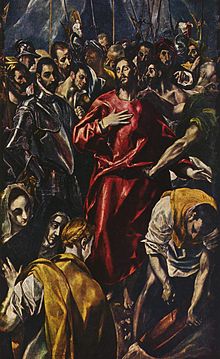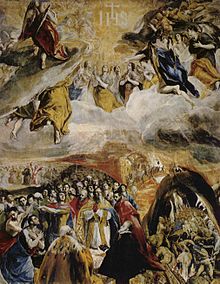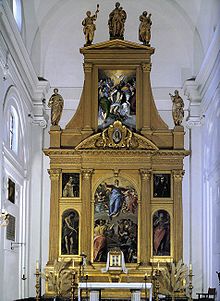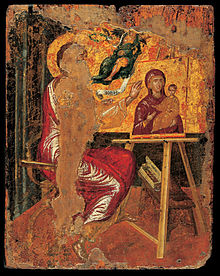El Greco
El Greco (Spanish el 'the', Italian Greco 'Greek'; b. 1541 in Candia, Crete; † 7 April 1614 in Toledo); actually Domínikos Theotokópoulos, (Greek Δομήνικος Θεοτοκόπουλος) was a painter of Greek origin and principal master of Spanish Mannerism and the late Renaissance. He was also active as a sculptor and architect. His artistic work began in Crete, where he trained as an icon painter in the Byzantine tradition. He moved to Venice and came into contact with the art of Titian before settling in Rome. Subsequently, El Greco arrived in Spain in an unexplained manner and moved to Toledo. Despite some conflicts, he was able to assert himself there and stayed until the end of his life.
El Greco mainly painted pictures with religious themes and portraits. In addition, there are a few landscapes and genre paintings. In Venice and Rome he adapted Western pictorial themes and artistic techniques. Thus he turned to oil painting and canvases as a painting ground. Towards the end of his stay in Italy, El Greco found a strong physicality in his figures, which continued in Spain. There he worked on large altar projects and produced portraits of influential people. El Greco often also designed the architectural framework for his altarpieces. His painting developed away from naturalism towards an individual style, as he attempted to find a new expression for spiritual phenomena, and in his later work increasingly referred back to his origins as an icon painter. El Greco enriched Catholic imagery with new subjects and a reinterpretation of familiar iconography. His art was less promoted by the nobility, but supported by intellectuals, clergymen and humanists.
The reception of El Greco was very different over time. With his individual style, he went his own way, which was largely independent of the development of painting in Spain. After his death, his art received little appreciation and was partly ignored. A slow rediscovery of El Greco began in the 19th century, around 1900 he had his breakthrough. This breakthrough was not so much driven by art historians, but by writers, art critics and the artistic avant-garde. He was seen as an important point of reference by modernist artists, especially expressionists, and received in works. In addition, he was used by Spanish artists and intellectuals to strengthen national identity.

El Greco and workshop, Disrobing of Christ, 165 × 99 cm, oil on canvas, 1590-1595, Alte Pinakothek in Munich

N. Perantinos: Bust of El Greco, Fodele in Crete, 1982
Live
Childhood and beginning of career
Domenikos Theotokopoulos, known as 'El Greco', was born in 1541 in Candia, then the capital of the island of Crete, now Heraklion. Fodele, 20 km away, also claims to be the artist's birthplace. However, this thesis is disproved today. His year of birth can be deduced from a document from 1606, in which El Greco described himself as 65 years old. At the time of his birth, Crete belonged to the Republic of Venice, for which his father Georgios Theotokopoulos worked as a state tax collector. The father was also a merchant, as was the artist's older brother, Manoussos, who was also a sailor. The family was not originally from Candia, probably the father immigrated from the region around Chania in the late 1520s. No information has survived about either El Greco's mother or his first Greek wife. Nor is anything known about El Greco's childhood. The family belonged to the island's middle class.
Since the Orthodox and Latin churches existed side by side in Candia, it is not clear to this day which of the two denominations El Greco's family belonged to. There was a school of icon painting on Crete that combined Orthodox tradition with Western influences brought to the island via prints from Venice. The Cretan workshops were popular both in the Eastern Mediterranean and in Venice. It was in one of these workshops that El Greco received his artistic training in the tradition of the Cretan school. In 1563, he was described in a document as a master icon painter. He must have been a recognized artist, for in 1565 the Cretan icon painter Georgios Klontzas appraised a Passion of Christ by him at the high price of 70 ducats. The second appraiser, a priest, even suggested 80 ducats as the price. The price of 70 ducats was in the range paid at the time for paintings by Venetian masters such as Tintoretto. This price valuation goes hand in hand with the assumption that El Greco was already the most highly valued painter in Crete before his departure for Venice, for on average artists in Candia fetched much lower prices than Venetians.
The earliest work still known today and signed by El Greco with his civil name is a motif of the Dormition of Mary. Painted in 1567, it has been hanging in the church of the same name in Ermoupoli on the island of Syros since around 1850.
Stay in Italy
In 1568 El Greco was present in Venice, as evidenced by a letter dated 18 August 1568. In it he informs us that he had sent drawings to the Greek cartographer Giorgio Sideris, called Calapodas. Sideris was among those intellectuals who had supported El Greco's slow rise. It is possible that the cartographer even provided the impetus for the move to Venice. Researchers assume that El Greco had already left for Venice in the spring or summer of 1567.
He stayed in Venice for three years and painted many pictures there. What unites them above all is that El Greco drew closer to the local artists such as Jacopo Bassano, Jacopo Tintoretto and Titian. In place of the gold ground, El Greco now used perspective space, drawing on architectural tracts such as that of Sebastiano Serlio. He also abandoned tempera painting, turned to oil painting, which had been widespread in the West since Jan van Eyck, and began to use canvas as a picture support. Nevertheless, he continued to paint many of his paintings with tempera until the end of his life, but then completed them with oil paints. El Greco's stay in Venice had a formative influence on his lighting and choice of colours.
In 1570, the miniature painter Giulio Clovio pointed out to his patron Alessandro Farnese in Rome a self-portrait of El Greco, now lost, that would have amazed Roman artists, and recommended that the artist be admitted to the Palazzo Farnese in Caprarola. He recommended El Greco to his patron as a pupil of Titian. The latter then painted a portrait of Clovio, perhaps in return for the recommendation. In the Palazzo Farnese, for example, he met the important humanist and librarian Fulvio Orsini, whose collection later included seven of El Greco's works. It is possible that through Orsini's friend Pedro Chacón he also met the ecclesiastical dignitary Luis de Castilla from Spain, with whom El Greco subsequently became close friends.
El Greco was not much in demand in the Farnese house, as fresco painters were mainly needed there. Although the collaboration of a Greek painter on the frescoes has been handed down, no work can be attributed to him. El Greco sought his own market niche as a portrait painter with his lost self-portrait, the portrait of Clovio and other works. With innovative portraits and other pictorial experiments such as the genre painting of a boy lighting a candle, he made a name for himself in the circles of Roman scholars and intellectuals. He also sought recognition in other genres, but in Rome he had to face competition from many high-ranking painters who worked in the tradition of Michelangelo. In order to set himself apart and to show his foreignness as a strength, El Greco referred to Titian. This is also the context of the anecdote handed down by Mancini, according to which El Greco offered the Pope to paint over Michelangelo's criticized Last Judgement in the SistineChapel. Thereupon he had to leave the city due to the criticism of the Roman painters.
El Greco was dismissed from the House of Farnese and decided to go his own way in Rome. On September 18, 1572, he paid the two scudi admission fee and thus joined the Roman Guild of St. Luke under the name Dominico Greco. He subsequently opened his own workshop in Rome, assisted at first by the Sienese painter Lattanzio Bonastri da Lucignano. Somewhat later Francesco Prevoste, who later accompanied El Greco to Spain, joined the workshop. There are no documents about the period from September 1572 to October 1576 that could give any clues as to what El Greco did during this period. Nor is it known why he left Italy.
First years in Spain
El Greco's presence in Spain is attested for October 1576 - how he got there is not known. There were close contacts between Rome and Spain at that time. Many Spaniards were staying in Rome, and numerous Italian artists were drawn to the Iberian Peninsula. During his stay with the Farneses, El Greco was able to establish contacts with Spaniards such as Luis de Castilla. Through de Castilla, El Greco received several commissions in Toledo, especially during the early part of his stay in Spain. Before coming to Toledo, he probably stayed briefly in Madrid, where he hoped to find employment at court. However, more precise information about this stop does not exist. Through the mediation of Diego de Castilla, his friend's father and dean of the cathedral, he created an altar for the Cistercian abbey of Santo Domingo de Silos in Toledo. He not only designed the pictorial programme, which was suited to the funeral chapel with the bodily assumption of Mary into heaven as the central image, but also designed the architecture of the retable, its sculptural decoration and the tabernacle.
Also through the mediation of Diego de Castilla, who was not solely responsible in this case, El Greco painted Christ Stripped of His Clothes for Toledo Cathedral. Conflict arose over the price and design of the painting, as it subsequently did for other paintings. In Spain at that time, the price of a painting was set after its completion by appraisers commissioned by the artist and the patron. El Greco's representative suggested the high price of 900 ducats, while the cathedral's representatives wanted to pay only 227 ducats. The large discrepancy was explained by the fact that there had been criticism of the painting. Normally El Greco would have had to rework the criticism, but he refused because he saw himself as the creator of his works and not merely the executive organ of his patrons. The conflict thus arose from the painter's different social position in Italy and Spain. In September 1579 there was a first settlement in this dispute for 317 ducats, but it did not last long. In 1585 there was another compromise, according to which El Greco was also to design the frame. Two years later the new price of 535 ducats for picture and frame was negotiated. The fact that the frame was valued higher than the painting in this context was due to the higher status of sculpture compared to painting in Spain at the time. El Greco did not change the iconography of the painting during this period, although the picture continued to hang in the main church of the diocese.
Unsuccessful aspirations to the court and contacts with the Inquisition
Between 1577 and 1579 El Greco painted the Adoration of the Name of Jesus, with which he wanted to recommend himself to King Philip II. In this painting he brought the king directly as a figure. In 1578 he had a son with his partner Jerónima de las Cuevas, about whom hardly any information has survived, who was named Jorge Manuel after his father and brother. Recent research on El Greco suggests that Jerónima de las Cuevas probably came from a family of craftsmen rather than the nobility, as is often assumed. The relationship did not last long, as Jerónima de la Cuevas died young.
Between 1580 and 1582, El Greco painted The Martyrdom of Saint Mauritius as a test painting for the church of the Escorial, in order to gain a foothold at court in Madrid after his successes in Toledo. In this situation, El Greco made a stylistic change from naturalism to a form of painting in which he sought creative expression for spiritualism. The king's intention in building the Escorial was to implement the ideas of the Council of Trent, which he had helped to shape. To this end, he actually wanted to entrust Juan Fernández de Navarrete with the design of all the altars. Navarrete died, however, so that new painters had to be sought. Perhaps because of the first painting with which El Greco wanted to recommend himself at court, the Adoration of the Name of Jesus, the king considered the Greek as a possible replacement. El Greco did provide an artistic painting, but it contradicted the ideals of the Council in its turn against naturalism. This work was well paid for and no corrections were made, yet El Greco received no further royal commissions as Philip II felt the painting was unsuitable for its destination. Instead of the intended place of display on the altar of the Escorial Church, the painting was hung in a less prominent place in the church. Philip II commissioned Romulo Cincinato to produce a painting on the same subject. He based his work on El Greco's composition, but changed its emphasis. For his work Cincinato received 500 ducats, while El Greco had received 800. The king's behavior demonstrated the emerging distinction between altarpiece and collector's painting. On the whole, this approach runs counter to anecdotal evidence and reports of the strong influence of the Inquisition on art production in Spain. It was precisely with the support of open-minded church circles that the Greek El Greco was able to develop Baroque pictorial ideas in Spain that did not take hold elsewhere until the seventeenth century.
El Greco had contact with the Inquisition on two occasions. In the first case, he worked on nine dates between May and December 1582 as a translator at a trial of a Greek servant who was accused of heresy but acquitted. The second contact had to do directly with El Greco and his art. After failing at court, the painter sought new patrons among the clergy of Toledo. His trial painting was a portrait of a cardinal, Fernando Niño de Guevara, who was Grand Inquisitor in Toledo around 1600.
Last years of life in Toledo
The rejection in Madrid strengthened El Greco's attachment to Toledo. On September 10, 1585, he rented a room in the palace of the Marques de Villena in the former Jewish quarter, where he occupied three apartments and lived alone with his son after the early death of his partner. He lived there until 1590 and then again from 1604. In 1589, El Greco was referred to in a document as a citizen of the city. On 18 March 1586, the priest of his own parish commissioned the painting The Burial of the Count of Orgaz. Between 1596 and 1600, El Greco painted the reredos for the Augustinian College of Doña María de Aragón in Madrid. For this work he received 6000 ducats, the highest price he could ever achieve for a painting.
On 9 November 1597, El Greco received a major commission to decorate the Capilla de San José in Toledo, his most important commission in Toledo after Santo Domingo el Antiguo. The contract included the two altarpieces and the design and gilding of the frame. His son, who began working for him that year, appeared as a name in a document in which he undertook to complete a work in the event of his father's death. From 1603 onwards, the son appears more frequently in documents relating to the workshop.
Despite numerous well-paid commissions, El Greco often found himself in economic difficulties, as he maintained a very upscale lifestyle. For example, he occasionally employed musicians to entertain him during meals. Between 1603 and 1607, there were conflicts over the painting program for the Hospital de la Caridad in Illescas. The contract contained terms unfavorable to El Greco, so that he was hardly reimbursed for his expenses and a lawsuit became necessary. One of the things that drew criticism was that rich citizens rather than poor ones were shown under the protective mantle of the Madonna. After El Greco's death, the ruffs were painted over for this reason. During this time he trained Luis Tristán, who became the most important painter of Toledo after El Greco's death and can be proved to have been a pupil in El Greco's studio between 1603 and 1606. In 1607 El Greco's son took over a leading position in the studio in place of the late Prevoste. Father and son received commissions from the Archdiocese of Toledo to examine the furnishings of churches for the orthodoxy of their pictorial programs. Subsequently, they were able to secure lucrative commissions on several occasions.
The following year, El Greco was commissioned by Pedro Salazar de Mendoza to paint three altarpieces for the Hospital de Tavera. However, this work remained unfinished. In 1611 Francisco Pacheco visited El Greco in Toledo. He produced both a portrait of the painter and a biography that appeared in his book on famous painters. Both of these testimonies are now lost. In his book El arte de la pintura, published in 1649, Pacheco published information about El Greco's working methods and artistic ideas. It was handed down from him that El Greco also worked as a theorist. El Greco died on April 7, 1614. Two Greeks were present at his deathbed as witnesses. Luis de Castilla subsequently settled his estate. At the time of his death, El Greco was heavily in debt. He left no will, which was unusual at the time.
Burial and estate
El Greco was first buried in the monastery of St. Dominic of Silos, where he had agreed in 1612 to set up a funeral chapel with an altar and the altarpiece of the Adoration of the Shepherds. In 1618 Luis de Castilla, the patron of the monastery, died, and as a result there was a dispute with the nuns over the price. For this reason, El Greco's son had his body moved to San Torcuato in 1619. This church was later demolished, with the loss of El Greco's remains.
Jorge Manuel Greco made an inventory of his father's possessions, which included 143 mostly finished paintings, including three versions of Laocoon, 15 plaster models, 30 clay models, 150 drawings, 30 plans, 200 prints, and over 100 books. The son's family remained living in his house. In 1621, on the occasion of the son's second marriage, an inventory of El Greco's possessions was made once again.

El Greco, Adoration of the Name of Jesus, 140 × 110 cm, oil on canvas, 1577-1579, El Escorial.

The main altar in the monastery of St. Dominic of Silos in Toledo

El Greco, Saint Luke paints an icon of the Virgin and Child, 41.6 × 33 cm, tempera and gold on wood, 1560-1567, Benaki Museum in Athens
Questions and Answers
Q: Who was El Greco?
A: El Greco was a painter, sculptor, and architect of the Spanish Renaissance. He usually signed his paintings in Greek letters with his full name, Doménicos Theotokópoulos (Greek: Δομήνικος Θεοτοκόπουλος).
Q: Where was El Greco born?
A: El Greco was born in Crete, which was the center of Post-Byzantine art at that time.
Q: Where did he move to after Venice?
A: After Venice, El Greco moved to Rome and opened a workshop and made a series of works.
Q: When did he move to Toledo?
A: In 1577, at the age of 36, he moved to Toledo, Spain where he lived and worked until his death in 1614.
Q: What style is El Greco known for?
A: El Greco is best known for long figures and often fantastic or dramatic coloring, combining Byzantine traditions with Western painting traditions. His paintings generally have very bright parts contrasting with very dark parts.
Q: How has El Greco's work been received over time?
A: Initially his dramatic and expressionist style puzzled other painters at the time but came to be appreciated in the 20th century. He is also considered to have influenced both the Expressionist and Cubist styles.
Q: Who were some poets or writers inspired by him?
A:El Greco's personality and works inspired poets and writers like Rainer Maria Rilke and Nikos Kazantzakis.
Search within the encyclopedia